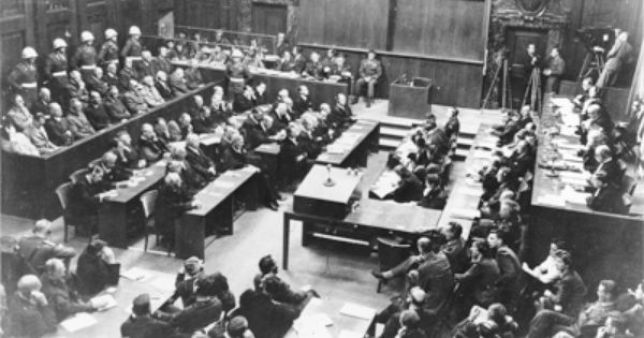Michele Battini, The Missing Italian Nuremberg, Palgrave MacMillan, 2007

“Battini’s excellent book tells a fascinating story of the immensely important trial against the entire Nazi military command in Italy for war crimes committed against civilians between 1943 and 1945. In short, of the ‘Italian Nuremberg.’ Or rather, what would have been the Italian Nuremberg, because this trial never happened. Battini presents massive evidence on how the Allies, especially the British, between 1945 and 1947, worked on the project of setting up such a trial. Battini interestingly probes the crucial and embarrassing question of why and how the project was eventually abandoned, in the face of the changing political context in Europe. Two larger and mutually related questions loom over the work: one is the painful and contested process of constructing a shared memory, the second is the subject of seeking international justice for war crimes against humanity.”–Marta Petrusewicz, Professor of History, Hunter College, City University of New York
“The book deals with a recent and significant historical subject: the problem of seeking international justice for war crimes against humanity. These considerations are highly relevant today, in matters ranging from the atrocities committed during the war in ex-Yugoslavia, to trying despots from the state of Iraq. Battini is a historian of ideas, and concentrates on what he rightly calls the Italian ‘deconstruction of memory’ in comparative perspective. Why have the Germans reached a reckoning day with their history, while the Italians have chosen the path of what Battini calls ‘a voluntary collective amnesia’? What is the importance in general of the reconstruction of memory, or its absence?”–Paul Ginsborg, Professor of History, University of Florence
Reviewed by Richard Nybakken, Published on H-Italy (December, 2008)
Commissioned by Dora M. Dumont
The Sins of Memory
“The time for rethinking the whole history of twentieth-century Italy (and Europe) is clearly upon us,” Michele Battini states in the new introduction to the English translation of his 2003 book on the “sins of memory.” The collapse of Soviet Communism, and the aftershocks that brought down most of Italy’s political class in the 1990s, also broke down old interpretive certainties regarding the country’s transition from fascism to democracy. Global events of the last two decades–South Africa, Rwanda, Yugoslavia, and now Iraq–have reinvigorated the “related question of justice,” and “re-opened the question of postwar and post-totalitarian retribution, and its contribution to collective amnesia” (pp. 14-15). In order to comprehend these issues, Battini argues, we must go back to the century’s iconic example of postwar justice–Nuremberg–not simply as the origin of a new legal genre (crimes against humanity), but as the source of Europeans’ forgetfulness regarding their complicity in the Nazi domination of Europe.
To be more precise, Battini’s book returns us to a trial that did not take place: the “Italian Nuremberg,” the Allies’ planned prosecution of German war crimes in Italy which, for a variety of domestic and international political reasons, was abandoned shortly after investigations began in 1946. The failure to hold such a trial, the author maintains, had “grave consequences, first on judiciary grounds and later regarding the assessment of historical truth.” Few of those accused of war crimes committed on the peninsula were prosecuted, most notably those assigned responsibility for the Fosse Ardeatine massacre, while the Italian government otherwise buried the evidence it had gathered for some fifty years in the so-called cabinet of shame –a “most Italian solution” which served to pacify both domestic tensions and diplomatic relations with the new West Germany, while also conveniently allowing Fascist war crimes in the Balkans to be quickly forgotten. On the level of historical “truth,” Battini concludes, the actual Nuremberg and its absent Italian counterpart created “a deformation of historical memory … founded on the separation of Germany’s responsibilities from those of other European nations and, therefore, on the forgetting of the faults of the Allied armies and the responsibilities of the European ruling classes for Nazism’s rise to power and their collaboration with Hitler’s New European Order” (pp. 21-23).
Battini’s argument thus echoes scholarship critical of Nuremberg not for its violation of the legal principle nullem crimen sine lege, but for its shortcomings as a didactic tool to “re-educate” politically prostrate European peoples; its broader outlines will be familiar to anyone who has read the acclaimed syntheses by Mark Mazower or Tony Judt.[1] If not path-breaking, Battini’s work nevertheless represents an important effort to correct the distortions of politically motivated historical revisionism and to situate contemporary Italy in a broader European context. While the book presupposes some knowledge of ongoing Italian debates on the “divided memory” of the Fascist era and the “crisis of anti-Fascism” in public discourse, it can be read profitably by both Italianists and generalists in modern Europe. The author brings a deep familiarity with his sources–the book is logically and literally an outgrowth of his work with Paolo Pezzino on the “war against civilians” during the German retreat through Tuscany in 1944[2]–and a critical engagement with the recent trend toward so-called anti-anti-Fascism. Like most good works of history it encourages several new avenues for exploration, particularly the comparison with the institutional memories of Vichy France and Nazi Germany.
The book should not, however, be considered the final word on its subject. The author raises an array of complicated issues, involving questions of juridical principles and legal theory, political and diplomatic history, collective memory and networks of cultural transmission and reception; in this slim volume, he is not able to treat all of these topics with the same methodological sophistication and detail. In particular, Battini often paints his comparative analysis in broad strokes; similarly, the role of judicial procedures in the diffusion of the “deconstruction of memory,” which Battini suggests is the main cause of the “cultural amnesia” of the book’s title, feels under-theorized. Perhaps most importantly, the author’s association of the “missing Italian Nuremberg” with the Allied failure to try German war crimes on Italian soil raises but does not fully answer important questions about Italians’ own inability or unwillingness to confront Fascism’s crimes or its place in Italian history and society.
After presenting his argument in chapter 1 (“The Deconstruction of Memory”), Battini uses subsequent chapters to unpack several interwoven legal, political, and cultural issues raised by his main thesis. Chapter 2 provides essential context: with the events of July-September 1943, Italy became a battleground of “three governments and two occupations,” the first defeated Axis power, and the latest Nazi victim. The Germans regarded the Italians’ actions as nothing less than betrayal, and their treatment of their former ally from September 1943 until May 1945 was correspondingly harsh, especially as the successes of the Allied armies began to mount (and the ranks of anti-Fascist partisan bands to swell) in central Italy during the summer and fall of 1944.
As Battini has thoroughly documented, the numerous massacres of civilians by the retreating German army were not–as popular memory would have it–solely the work of the vicious SS, nor the excesses of those provoked into retaliation by intemperate partisan aggression; rather, many were the result of the deliberate, coordinated execution of what Battini, following the lead of Allied investigators, terms a “machinery of reprisals.” Responsibility for the planning and implementation of this “machinery” fell, beginning in May 1944, to the head of the German army in Italy, field marshal Albert Kesselring. Battini shows that Kesselring “from the beginning sought to control the war against the Partisan bands, trying to wrest it from the SS and the police.” The marshal’s “military treatment” of the anti-partisan war, in contrast to that advocated by Otto Rahn (the Reich’s Foreign Ministry representative, nominally in charge of civilian affairs), “reduced the Resistance–all the Resistance, even the unarmed one of the civilian population–merely to a military affair,” unleashing “a war without quarter that involved the civilian population to a great extent” (pp. 48-49).
Having established the gravity of the events in question, Battini examines the American and British response. The Allies, of course, were determined–despite the legal ambiguities and lack of precedent in the framework of international law–to prosecute such activities under the rubric of “crimes against humanity.” From the beginning, however, their investigations were compromised by Italy’s singular position as a defeated former enemy and junior partner in the anti-Nazi alliance. After Italy was granted “co-belligerent” status in October 1943, for instance, the UN War Crimes Commission added Italy to its area of competence; it could not, however, allow the Italians to participate actively in the commission’s activities, as it was simultaneously on the list of countries to be investigated for the commission of war crimes prior to September 1943 during the Fascist government’s participation in the Axis.
Despite these inherent procedural difficulties, from April 1945 until April 1946 the Allies prepared the legal and investigative foundation to put the “machinery of reprisals” on trial. Between April and August 1946, however, three factors compelled the Allies to reconsider and ultimately to quash the “Italian Nuremberg”: the success of the Italian Socialist-Communist popular front in the spring 1946 local administrative elections and defeat of the monarchy in the June constitutional referendum; the differences between the United States and the Soviet Union over the judicial authority responsible for the trials; and, finally, the contentious relations between the Allies, Italy, and Yugoslavia regarding the prosecution of Italians responsible for war crimes in the Balkans. Each of these three issues exposed latent discord in the Allied partnership, ultimately calling into question the practical and moral utility of the trials as a device to democratize the country and solidify its place (as well as that of Germany) in the Western alliance.
The decision to abandon the Italian Nuremberg, and to hold in its place a series of separate high-profile trials, Battini concludes, eviscerated the evidence of the “machinery of reprisals”; responsibility for the prosecution of the war was instead attributed solely to Kesselring and a handful of his subordinates. In chapters 3 and 4, Battini recapitulates the dramatic trial of the marshal, which took place before an English military court in Venice from February-May 1947 (Kesselring was convicted and sentenced to death). Between fall 1946 and mid-spring 1947, Italian politics witnessed a dramatic shift: the tide of radical reform which had so alarmed British authorities following elections in April 1946 crested with the victory of the republic in the June referendum; by January 1947 prime minister Alcide De Gasperi had quarantined the left-wing presence in his cabinet to a number of minor ministries (shortly after the trial’s conclusion he would exclude the Communists entirely). As the Italian Communist Party moved into outright opposition to the government and sought to use their anti-Fascist credentials as a badge of democratic legitimacy, Allied policymakers began to see the high-profile public prosecution of war criminals like Kesselring as a liability which threatened to remind voters of the ruling classes’ complicity with the Nazi regime.
In chapter 5, Battini assesses the impact of legal-juridical categories on the “substance of the trial” and the political-cultural work of constructing meaning from the past. Throughout Europe, he argues, judicial proceedings “played an authentically political part” in postwar political crises, while “political authorities played an often ambiguous public and civil role, arbitrarily selecting what should be remembered and what to consign to oblivion for the sake of the new identity conceived for their own country” (p. 121). In Italy, where both the state and the idea of the nation underwent profound crises of legitimacy, “national identity was entrusted, above all, to the Italian people’s shared feelings about the war, the defeat, the German occupation, and the resulting suffering” (p. 123). This argument is only partially convincing, for Battini’s sources do not truly allow him to address the mechanisms of transmission (in the Italian media, among the political parties, to the man in the street) by which this identity would have been shared or imparted. In this respect, Battini has brilliantly reconstructed what Richard Ned Lebow has categorized as “institutional memory”; what is less clear here is how this form of remembrance interacted with the “individual” or “collective” memories of important figures or societal groups.[3] Without these perspectives, however, it is difficult to understand whether Kesselring’s trial was as significant as the author maintains.
While the author strives throughout the book to place Italy into a broader European context, this comparative dimension is somewhat underserved by chapter 6 (“The Mirror of Vichy”). He ably summarizes Vichy historiography, but he does not provide much explicit analysis of how the French case has influenced how we see those of other European nations. Battini states succinctly that the “conscious substitution of the memory of Vichy collaboration with the Gaullist myth of an undivided France, united in the most strenuous Resistance … can be taken as a paradigm for those of many Western democracies built on oblivion” (pp. 26-27). Unfortunately, he leaves it to the reader to infer how the very distinct cases of Austria, Germany, or Italy–all of whom experienced fascistic regimes before the war, and thus might be better defined as perpetrators rather than collaborators–compare or contrast with the “Vichy Syndrome.”
A final point concerns the selection and implications of the book’s title. It is significant that Battini uses the “missing Italian Nuremberg” not to describe the never-held trials of those responsible under Fascism for the brutal occupation of Greece, Yugoslavia, or North Africa, but rather “to indicate the lack of a global procedure against those responsible for the system of Nazi occupation in Italy starting in September 1943” (p. 17). If one of the symptoms of the “Italian disease” (by which Battini means the viewpoint which tends to minimize the evils of the Fascist regime) is the insistence of politicians and the media on the fundamental innocence of the Italians as a “good people” (brava gente), one of its primary causes and/or consequences is the tendency to view Italy as a passive subject–or victim–of more powerful actors and global events. By emphasizing Allied decisions regarding the prosecution of German war crimes as the source of Italians’ cultural amnesia, Battini appears to risk perpetuating one of the very stereotypes he otherwise seeks to address.
It is of course unfair to criticize an author for not writing a different book, and to his credit, Battini engages recent work on the purges, drawing a distinction between the treatment of collaborators (an “administrative problem”) and criminals (a legal matter). However, for a fuller perspective, one should supplement Battini’s book with other works on the failure of the Italian government to acknowledge its responsibility or punish those who committed crimes under Fascism. Nevertheless, one hopes that Battini’s work will be widely read and debated, and that the questions he raises will be taken up by those historians seeking to understand Italy’s ongoing fascination with Fascism, and a past that will not pass.
Notes
[1]. Tony Judt, Postwar: A History of Europe since 1945 (New York: Penguin, 2005); and Mark Mazower, Dark Continent: Europe’s Twentieth Century (New York: Knopf, 1999). [2]. Michele Battini and Paolo Pezzino, Guerra ai civili: occupazione tedesca e politica del massacro: Toscana 1944 (Venice: Marsilio, 1997). [3]. See Richard Ned Lebow, “The Memory of Politics in Postwar Europe,” in Richard Ned Lebow, Wulf Kansteiner, and Claudio Fogu, eds., The Politics of Memory in Postwar Europe (Durham: Duke University Press, 2006), 1-39.








